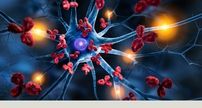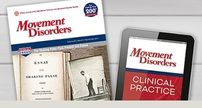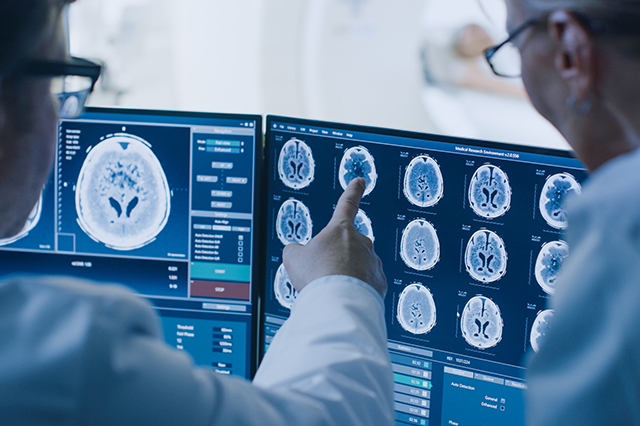Ataxia
Clinical Overview
Ataxia, defined as incoordination of voluntary muscle movement, is a neurological sign, not a disease. Ataxia can be the chief complaint or part of the presenting symptoms, and it is usually caused by cerebellar dysfunction, impaired vestibular or proprioceptive afferent input to the cerebellum. Patient with ataxia usually present with poor coordination, unsteady gait with a tendency to stumble, difficulty with fine motor tasks, impaired swallowing, and abnormalities in eye movements. Neurologists should be familiar with specific terms for ataxia and use them appropriately when communicating with colleagues. The following clinical terms are often used in describing ataxia, including sensory ataxia, limb ataxia, gait ataxia, titubation, dysdiadochokinesia, intention tremor, dysmetria, scanning speech, square-wave jerks/ocular flutter/opsoclonus and nystagmus. It is important to understand the nomenclature because it sometimes implies a certain ataxic disorder.
Ataxia may have an acute onset, especially those ataxias resulting from stroke, hemorrhage, or infection of the cerebellar and/or its afferent or efferent, which can have a rapid progression with catastrophic impact. It can also have an insidious onset with a chronic and slowly progressive clinical course (hereditary ataxia, eg, spinocerebellar ataxias [SCAs]). Some patients have a subacute onset, as due to certain medications, alcohol abuse or from immunologic (eg, paraneoplastic syndromes) or infectious disorders, which may just have a narrow therapeutic window. A prompt management strategy for treatable causes of ataxia should not be missed. Of course, ataxia can also be benign in symptomatic disorders (eg, vestibular neuritis).
View complete description
A complete family and personal history, physical examination, and neuroimaging, as well as comprehensive laboratory evaluation may be required for the diagnosis of ataxic syndromes. However, in many cases, etiology of ataxia remains uncertain despite a complete workup.
The causes of the ataxia in childhood, adolescent and adulthood are different. The following is some principles which provide the physician better diagnostic clues. In children, recessive causes of ataxia are more common, including Friedreich’s and a list of inborn errors of metabolism disorders, such as juvenile forms of GM2 gangliosidoses, and sulfatide lipidoses (metachromatic leukodystrophy). Friedreich’s ataxia usually occurs in children and in young adults, and this disease has occasionally been described in older individuals. Hereditary ataxia with vitamin E deficiency, an autosomal recessive disorder, can present with symptoms very similar to those found in Friedreich’s ataxia. Abetalipoproteinemia is another recessive cause of vitamin E deficiency related ataxia, and the disease severity depends on the deficit and the related vitamin E deficiency. Vitamin 12 deficiency occasionally present with chronic ataxia, often related to loss of proprioception. Cerebrotendinous xanthomatosis (CTX) is another rare, autosomal recessive lipid storage disorder. Neurological symptoms generally start at approximately 20 years of age and cerebellar ataxia is one among the other neurological symptoms. Associated, non-neurological features include congenital/juvenile cataracts, tendon xanthomas (particularly of the Achilles tendons), premature atherosclerosis are unique symptoms that distinguish CTX from other lipid storage disorders. Ataxia-telangiectasia, this rare, progressive childhood disease causes degeneration in the brain and other body systems. The disease also causes immune system breakdown (immunodeficiency disease), which increases susceptibility to other diseases, including infections and tumors. Children with ataxia-telangiectasia are at high risk of developing cancer, particularly leukemia or lymphoma. Telangiectasias are tiny red "spider" veins that might appear in the corners of patient’s eyes or on the ears and cheeks. Recurrent sinus and respiratory infections are common. Most people with the disease need a wheelchair by their teens and die before age 30, usually of cancer or lung (pulmonary) disease.
In older patients, autoimmune syndromes including paraneoplastic syndrome (eg, Anti Yo and anti Hu) can result in ataxia. Celiac disease, is an autoimmune disease with anti-gliadin antibodies, may result in ataxia. With the advance of the new technology, the diagnosis of genetic causes of ataxia has become more complex. There are more than 40 autosomal dominant ataxias, including 7 most important ataxias caused by CAG repeats encoding a polyglutamine protein domain (SCA 1, SCA2, SCA3, SCA6, SCA7, SCA17, DRPLA). Cerebellar ataxia and cerebellar degeneration are common to all types, but other signs and symptoms, as well as age of onset, differ depending on the specific gene mutation.
Episodic ataxias (EA) are a group of rare and defined dominantly inherited ataxias. Currently, there are 8 type of EAs. Among them, EA1 and EA2 are most important. In EA1, episodes of ataxia with gait imbalance and slurring of speech, occur spontaneously. This type of ataxia can also be precipitated by sudden movement, excitement, or exercise. The attacks generally last from seconds to several minutes at a time and may recur many times a day. In EA2, ataxia lasts hours to days, with interictal eye movement abnormalities. Stress commonly precipitate the episodes. EA2 notably is due to a genetic defect in a calcium channel (CACNA1A). Different genetic defects of this gene can cause familial hemiplegic migraine, and a CAG repeat in this gene causes SCA6, and there are overlaps in symptomatology. The life span is not shortened in EAS, and symptoms might respond to medication. Acetazolamide may be helpful in the treatment of episodic ataxia.
Although ataxia can be easily recognized, however, the investigation of underlying causes requires systematic evaluation. Other neurologic disorders that can give rise to similar problems with gait and dexterity (eg, neuropathy or spinal cord diseases) can usually be distinguished by neurological signs alone. In acute settings, the main mission is to recognize life-threatening events. In nonacute settings no simple algorithm or guideline to follow exists. Being familiar with ataxia disorders will help physicians perform prompt appropriate laboratory and diagnostic tests to confirm the diagnosis. Finding an etiology sometimes is a daunting task in some situations, but after the offending factor is removed in acquired ataxia, the disease progression normally stops and the patient will recover. With early intervention, especially at a young age, most patients compensate well and will only have very mild incoordination or none at all.
For the genetic causes of ataxia, several agents have been inconsistently reported to improve ataxia. Thus the management is typically supportive, which may include physical, occupational, and speech therapy.
Hubert Fernandez, MD
Center Director, Center for Neurological Restoration
Cleveland Clinic
Cleveland, OH USA
2019 Updates Contributed by:
Yih-Ru Wu, MD
Deputy Director, Department of Neurology, Chang Gung Memorial Hospital, Linkou Branch, Taiwan
Professor, Chang Gung University College of Medicine, Taoyuan, Taiwan
View Ataxia: |

Video Case Library
Browse an archive of nearly 2,000 case videos and other multimedia. ✪ MEMBERS ONLY

Patient Handout
Ataxia: Essential Facts for Patients
Handouts on movement disorder topics for physicians and patients, translated into multiple languages.
Information
Showing page 1 of 2
Skip to PaginationEditor's Picks: Recommended Papers
Useful reference papers about ataxia, curated by the MDS Website Editorial Board.
Latest Insights & Media
Discover the latest coverage, analysis, and expert commentary about ataxia
![]()
Highlights in ataxia • 2025 MDS Congress
- Ataxias
- Podcast
![]()
Unravelling the Global Tapestry of Genetic Ataxias: Epidemiology and Genetic Testing Approaches
- Ataxias
- Published paper
![]()
Artificial intelligence in the diagnostic approach of chronic ataxias
- Ataxias
- Podcast
![]()
Movement Disorders after Dengue Virus Infection: A Scoping Review
- Ataxias
- Environmental Risk factors
- Published paper
![]()
A new pathway to find structural variations in inherited neurological cases - the SCA4 example
- Ataxias
- Podcast
![]()
ANO10-Related Spinocerebellar Ataxia: MDSGene Systematic Literature Review and a Romani Case Series
- Ataxias
- Published paper
![]()
Discovery of new repeat expansion disorders in ataxia and beyond
- Ataxias
- Genetics
- Web article
![]()
The genetic nomenclature of recessive cerebellar ataxias
- Ataxias
- Published paper

Fundamentals: Approach to Ataxias
Understand the definition and phenomenology of ataxia and learn to identify, diagnosis, and treat acquired and genetic cases.












